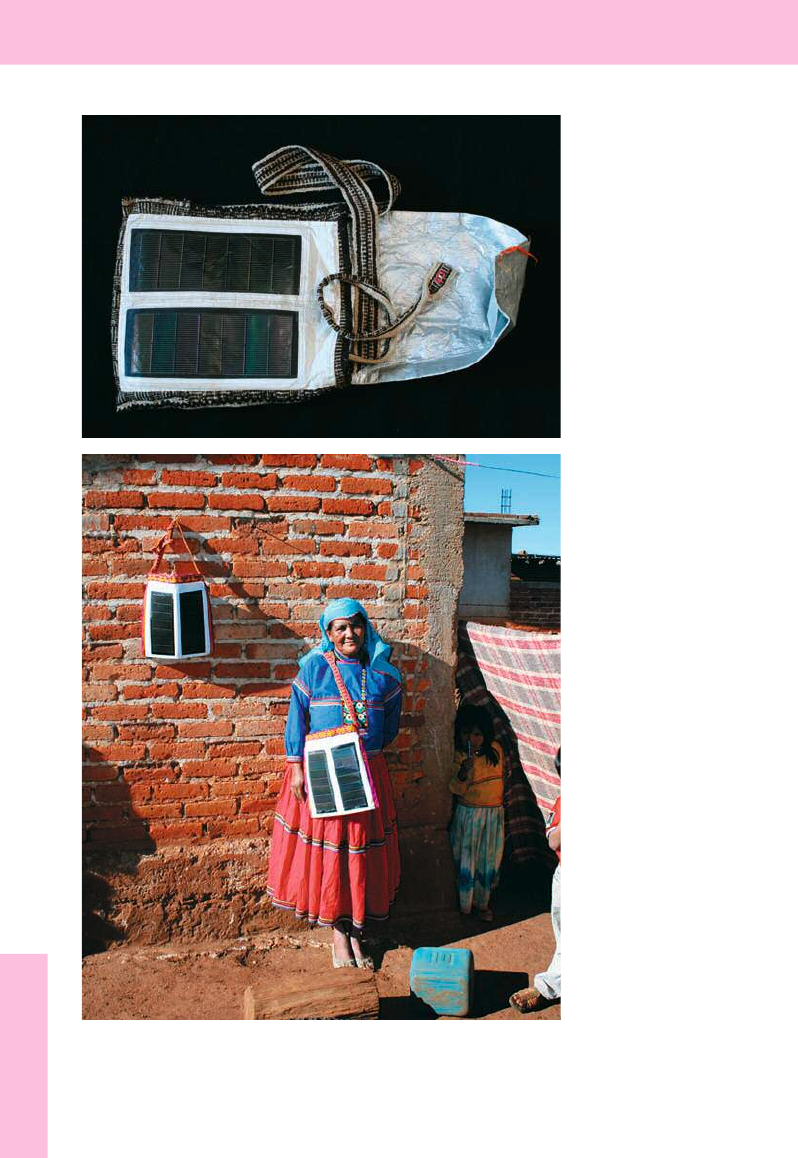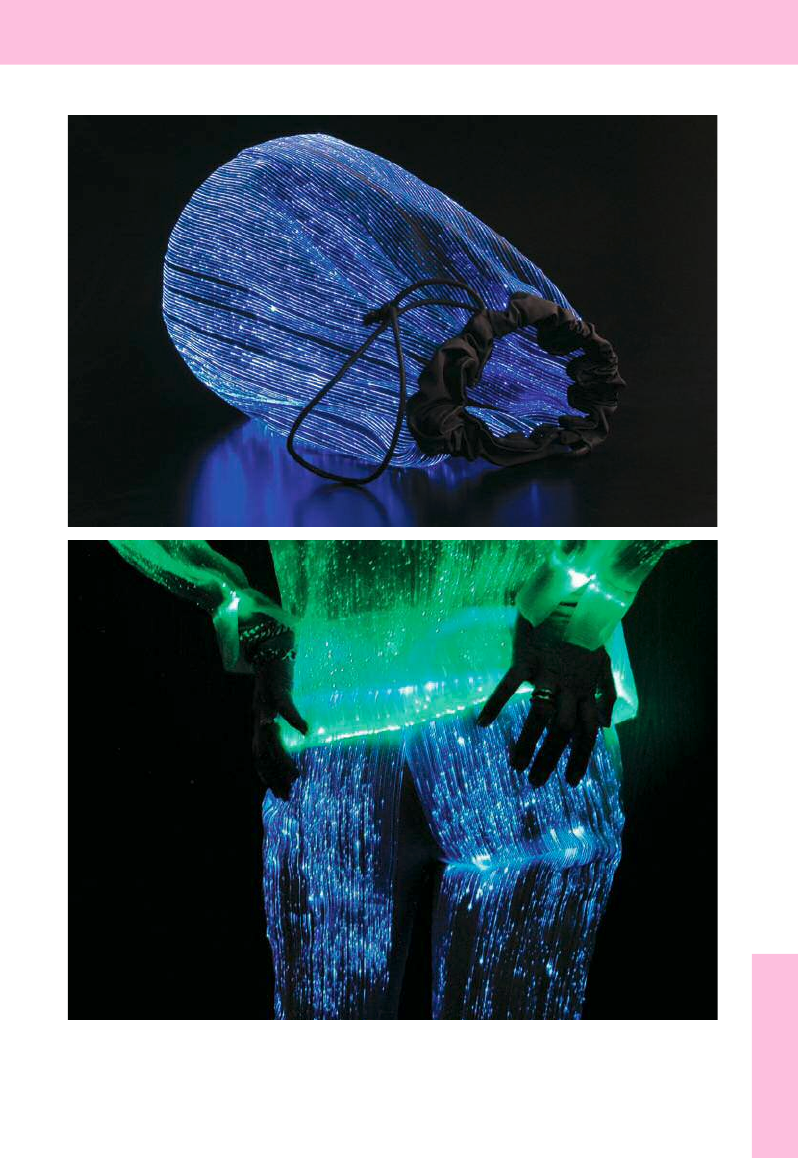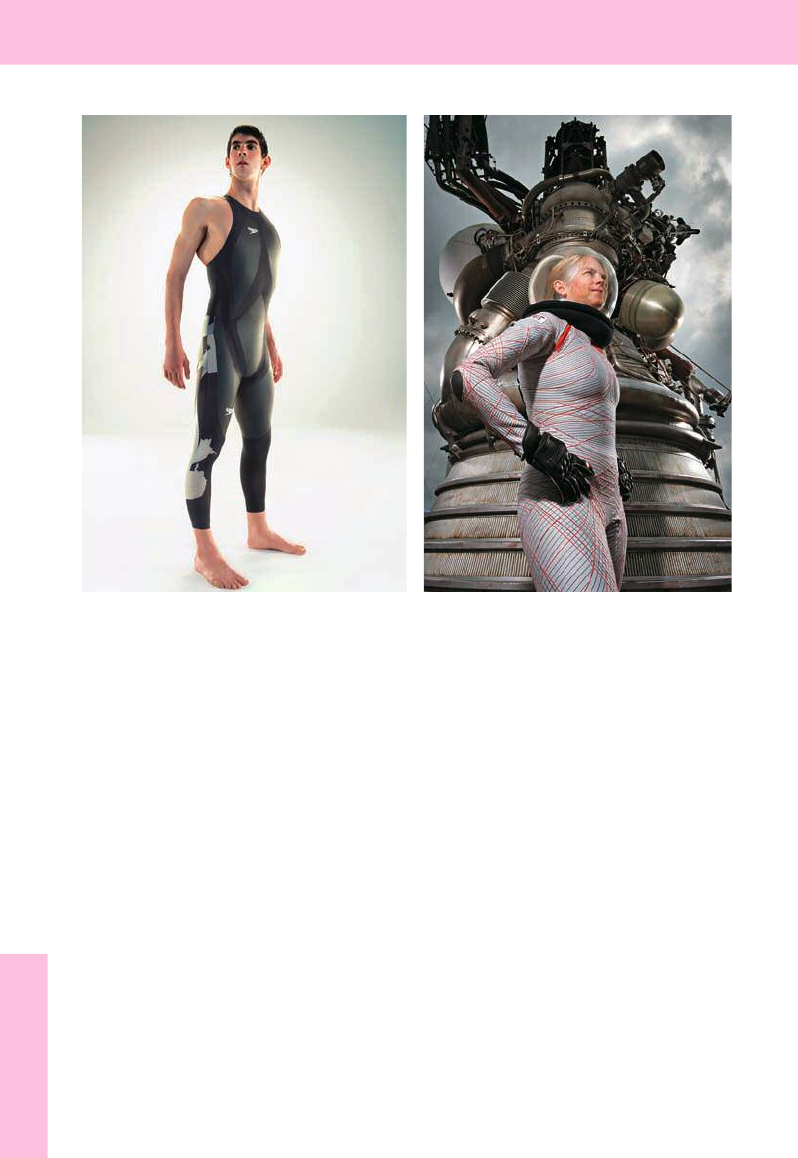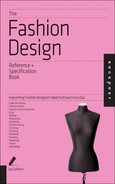
Job:02-30034 Title:RP-Fashion Design Ref and Spec Book
#175 Dtp:225 Page:242
242_247_30034.indd 242 2/27/13 6:18 PM
242 THE FASHION DESIGN REFERENCE + SPECIFICATION BOOK
(Text)
Chapter 24: Technology and Sustainability
Throughout fashion history, science and technology have been responsible
for providing designers with new means for solving design challenges. The
industrial revolution mechanized production. The rst automobiles popular-
ized duster coats, just as motorcycles would later popularize leather jackets:
both garments were designed for protection on the road and both became a
part of the overall style of the period. In World War II the military’s need for an
inexpensive alternative to silk for parachutes led to the development of rip-stop
nylon, now widely used in sportswear and outerwear. Advancements in environ-
mental control through heating, ventilation, and air conditioning freed fashion
designers from accountability to natural elements. The aerospace industry put
Velcro fasteners to use in space suits; skiers and scuba divers recognized its
value and adapted it to their sports; soon after, Velcro appeared in children’s
clothes, bringing it into the mainstream of clothing design.
S
C
S
In
a
th
n
te
re
so
b
sa
S
T
ic
lik
th
in
a
s
o
e
ti
L
L
e
m
L
co
tu
in
In atable dress by Diana Eng and Emily Albinski
Photograph by Douglas J. Eng/DougEngPhoto.com.
24
Job:02-30034 Title:RP-Fashion Design Ref and Spec Book
#175 Dtp:225 Page:242
242_247_30034.indd 242 2/27/13 6:18 PM

Job:02-30034 Title:RP-Fashion Design Ref and Spec Book
#175 Dtp:225 Page:243
Book
e:242
242_247_30034.indd 243 2/27/13 6:18 PM
24 3
(Text)
SCIENCE OF STYLE
Computational Couture
Students of technology and fashion from prominent institutions such as the Massachusetts
Institute of Technology, Harvard University, New York University, Parsons School of Design,
and Rhode Island School of Design have gathered at MIT to explore creative clothing through
the lens of technology. “Seamless: Computational Couture” is an event that showcases in-
novative and experimental works in computational apparel design, interactive clothing, and
technology-based fashion. As the name implies, the designs make apparent the seamless
relationship between the fashionable and the high-tech. Steps beyond performance fabrics,
some of the works featured over the years have included computer-generated knit patterns,
boots that change shape based on the speed of the wearer, a shirt with sensors that mas-
sage the wearer, and an inflatable dress that establishes personal space boundaries.
Solar Textiles
The fashion techie might be familiar with a futuristic-looking knapsack whose solar photovolta-
ic panels collect energy to charge personal electronic devices. The development of membrane-
like surfaces that function in the same way, but that can be draped like curtains, provides
the modern fashion designer with a new way of thinking about energy and style. The nonprofit
initiative Portable Light Project has responded to the need in remote communities for depend-
able, easy-to-use, adaptable materials that are durable enough to serve as renewable energy
sources. Their textiles that incorporate flexible solar nanotechnology allow women to weave
energy-harvesting bags using a simple backstrap loom. Their work only hints at the possibili-
ties for the two billion people around the world who live without electricity.
Luminex
Luminescent fibers that can be attached to a microchip with a battery source enable design-
ers to add light to their material palette. Originally developed for high-energy physics experi-
ments, the fiber’s fineness and flexibility allows it to be easily incorporated into textiles.
Luminex fibers can be customized as to shape, size, thickness, finish, density of illumination,
color, pattern, and programmability. These light-emitting fabrics have been used in stage cos-
tumes for their theatricality and in handbag linings for their practicality, and are being woven
into a variety of fashion textiles.
Photograph by Douglas J. Eng/DougEngPhoto.com.
24
Job:02-30034 Title:RP-Fashion Design Ref and Spec Book
#175 Dtp:225 Page:243
Book
e:242
242_247_30034.indd 243 2/27/13 6:18 PM

Job:02-30034 Title:RP-Fashion Design Ref and Spec Book
#175 Dtp:225 Page:244
242_247_30034.indd 244 2/27/13 6:18 PM
24 4 THE FASHION DESIGN REFERENCE + SPECIFICATION BOOK
(Text)
Portable Light Project by KVA MATx, used by the Huichol
Indians of Sierra Madre, Mexico
Photographs courtesy of KVA MATx/Kennedy & Violich Architecture.
Photograph courtesy of Luminex S.p.A.
24
Job:02-30034 Title:RP-Fashion Design Ref and Spec Book
#175 Dtp:225 Page:244
242_247_30034.indd 244 2/27/13 6:18 PM

Job:02-30034 Title:RP-Fashion Design Ref and Spec Book
#175 Dtp:225 Page:245
Book
e:244
242_247_30034.indd 245 2/27/13 6:18 PM
Technology and Sustainability 2 45
(Text)
Garments made with Luminex fabric
Photograph courtesy of Luminex S.p.A.
24
Job:02-30034 Title:RP-Fashion Design Ref and Spec Book
#175 Dtp:225 Page:245
Book
e:244
242_247_30034.indd 245 2/27/13 6:18 PM

Job:02-30034 Title:RP-Fashion Design Ref and Spec Book
#175 Dtp:225 Page:246
242_247_30034.indd 246 2/27/13 6:18 PM
24 6 THE FASHION DESIGN REFERENCE + SPECIFICATION BOOK
(Text)
LZR Racer
The design of Speedo’s LZR Racer swimsuit combines the careful placement of seams with
a new high-performance fabric to produce a garment that minimizes drag, maximizes muscle
support, and does not constrain motion. The TLZR Pulse textile is a high-density weave of very
fine nylon and spandex microfibers that is designed to be super-lightweight and water-repel-
lent. Nor has style been forsaken. Speedo collaborated with one of the most forward-looking
fashion designers, Rei Kawakubo for Comme des Garçons. She transferred a calligraphic
painting by Japanese artist Inoue Yu-ich onto the suit; the graphic print reads kokoro, which
means “heart, mind, spirit, feeling.”
Bio-Suit
Twenty-first-century fashion might need to take a cue from the work of Dr. Dava Newman of the
Massachusetts Institute of Technology. Working with Guillermo Trotti and the Italian company
Dainese, makers of motorbike and extreme sports apparel, she has created the right balance
of biomechanics, human factors engineering, modeling, and design for a Bio-Suit System that
hopes to revolutionize human space exploration. Using mechanical counterpressure to estab-
lish the necessary internal pressure, Newman’s invention replaces bulky, awkward space suits
Michael Phelps in a LZR Racer Suit by Speedo
Photograph courtesy of Speedo.
Dava Newman modeling a Bio-Suit prototype
Dava Newman, inventor, science, and engineering; Guillermo Trotti,
design; Dainese, S.p.A., fabrication. Photograph by Douglas Sonders.
w
Ti
20
sc
N
N
a
th
fo
of
b
se
cr
T
st
a
a
Fr
th
o
b
B
P
in
ex
e
w
fe
a
Reproduced with the permission of Linden Research, Inc.
Copyright © 2001–2009. All rights reserved.
24
Job:02-30034 Title:RP-Fashion Design Ref and Spec Book
#175 Dtp:225 Page:246
242_247_30034.indd 246 2/27/13 6:18 PM
..................Content has been hidden....................
You can't read the all page of ebook, please click here login for view all page.
